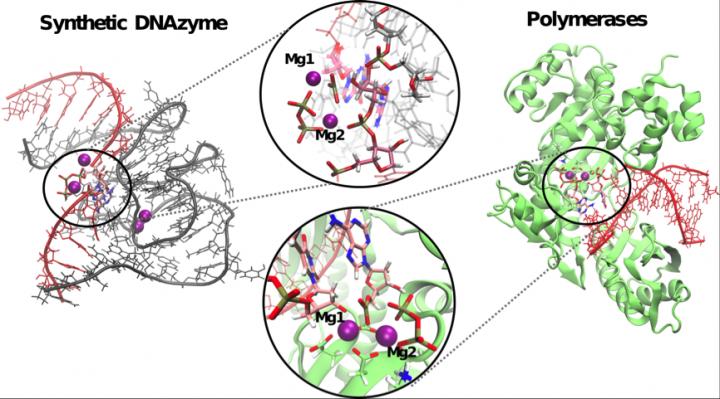
Credit: Juan Aranda, IRB Barcelona
A study from the Institute for Research in Biomedicine (IRB Barcelona) has published a study in the journal Nature Catalysis that describes the reaction mechanism used by the DNAzyme 9DB1, the first structurally available catalyser formed by DNA.
Until recently, it was widely assumed that DNA served to store genetic information in a stable and irreversible manner. However, in the last ten years, the discovery of the epigenetic code and the finding that nucleic acids can also catalyse certain reactions have changed this vision.
The team headed by Modesto Orozco, head of the Molecular Modelling and Bioinformatics Lab at IRB Barcelona, found that this DNAzyme catalyses RNA ligation through a similar mechanism to that used by natural enzymes.
The conclusion drawn by the study may lead to improvements in current catalysers and in the design of novel biocatalysers formed by DNA. Indeed, given that DNAzymes can carry out a variety of reactions on messenger RNA and can trigger the silencing of genes, they are being developed for diagnostic and biomedical applications.
“The role of DNAzymes as catalysers is of great interest since they are easier to synthesise than proteins and RNA molecules, as well as being more stable and less expensive. However, to date, the catalytic mechanism used by DNAzymes was unknown, as were the differences between catalysers made of DNA and RNA or the protein enzymes,” says Orozco, senior professor at the University of Barcelona.
The study published by the IRB Barcelona team aimed to unravel the details of the catalytic mechanism of DNAzymes. To this end, Juan Aranda and Montserrat Terrazas, postdoctoral fellows at IRB Barcelona and first authors of the work, studied DNAzyme 9DB1 at the atomic level using computational simulations and then experimentally validated their findings.
The various computational techniques, ranging from molecular dynamics to the combined use of quantum mechanics and classical mechanics, included in the study have allowed the characterisation of the catalytic state of 9DB1. Using these approaches, the researchers have achieved the first atomic description of the reaction mechanism of a DNAzyme and have characterised the most important interaction in the catalysis and in the transition state of the reaction.
They have experimentally synthesised in vitro variants of 9DB1 to confirm the mechanism that was predicted through the computational approach. The reaction mechanism used by the DNAzyme resembles that of polymerases, which use two divalent cations.
Finally, the scientists have analysed the differences and similarities between the catalytic capacity of DNA, RNA and polymerases. Such atomic information is expected to lead to the design of more efficient DNAzymes.
###
The study has been funded by the Ministry of Science, Innovation and Universities, the Catalan Government, the Spanish National Bioinformatics Institute, the European Research Council (ERC), the Horizon 2020 Programme of the European Union, and the European Regional Development Fund (ERDF).
Reference article:
Juan Aranda, Montserrat Terrazas, Hansel Gómez, Núria Villegas y Modesto Orozco
An artificial DNAzyme RNA ligase shows a reaction mechanism resembling that of cellular polymerases
Nature Catalysis (2019) DOI: 10.1038/s41929-019-0290-y
Media Contact
Communications IRB Barcelona
[email protected]
Original Source
https:/
Related Journal Article
http://dx.




